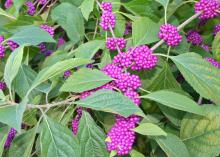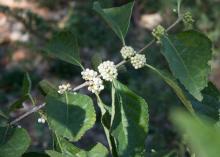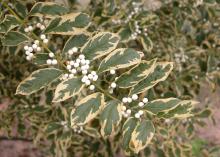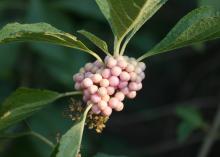Information Possibly Outdated
The information presented on this page was originally released on October 14, 2013. It may not be outdated, but please search our site for more current information. If you plan to quote or reference this information in a publication, please check with the Extension specialist or author before proceeding.
American beautyberry shines in Mississippi
You probably have figured out by now that I have a lot of favorite plants. Since it’s autumn, I get to talk about one of my favorite native plants that is in its full glory right now.
The American beautyberry is really putting on quite a show in Mississippi with clusters of bright purple berries.
American beautyberry is commonly found on the edges of woodlands all across the state. It is widely found east of the Mississippi in the mid-Atlantic and Gulf Coast region of North America.
Despite its native status, American beautyberry is quite at home in the landscape. Beautyberry comes in different maturity sizes and berry arrangements, but all are referred to as beautyberry in garden centers and nurseries.
Beautyberry is a great native deciduous plant that has three seasons of interest. Small, pink flowers appear in the leaf axils of paired leaves in the spring. Unfortunately, these flowers are inconspicuous but play an important role for later in the season. The summer foliage is a rich green that provides a good background for summer-blooming perennials and shrubs.
In the fall, beautyberry joins Mother Nature’s color chorus as its leaves transform into a deep, rich purple. However, the berries are the real fall show. Bright, shiny, purple berries are arranged in clusters at the leaf nodes all along the arching stems. The purple berries appear to have a metallic quality when sunlight reflects off them. Quite often the berries persist well into winter.
If this isn’t your color, you will be happy to learn you are not limited only to purple berries. Alba is a white-berried selection of American beautyberry whose groups of shiny, white berries stand out in shady nooks in the garden and landscape. The berries of Welches Pink have a lustrous, pink-blush sheen.
If you like variegated plants, try the variegated beautyberry called Duet. The foliage is green with variable yellow margins, and it produces white berries.
Duet has a special place in the garden for me because I discovered this selection. It is the only stable variegated beautyberry in the nursery trade. Check local nurseries for availability.
American beautyberry grows up to 4 feet tall and wide. In north Mississippi, this plant may die back to the ground in severe winters. It is a good practice to prune the plant back in early spring to about 6 inches. This practice creates a fuller and more compact plant when new growth appears.
Beautyberry has a loose and open habit. One plant can be attractive, but a grouping of two or three creates a full cluster. The plants cross-pollinate to ensure the fullest fruit production. Beautyberry tolerates dry soil conditions and part shade, but the healthiest plants and best fruit production happen in full sun. Be sure to maintain consistent soil moisture for best performance.
Beautyberry works well tucked in behind other fall-blooming plants. They add a soft background during the summer months and dazzle in the fall with their metallic-colored berries.
Be warned that these beautyberry selections may not be available at all local nurseries, so do your research early and ask for them where you buy plants.











